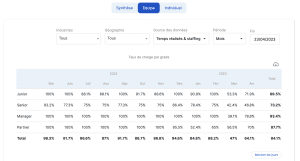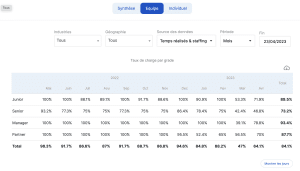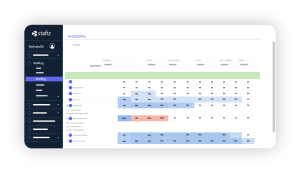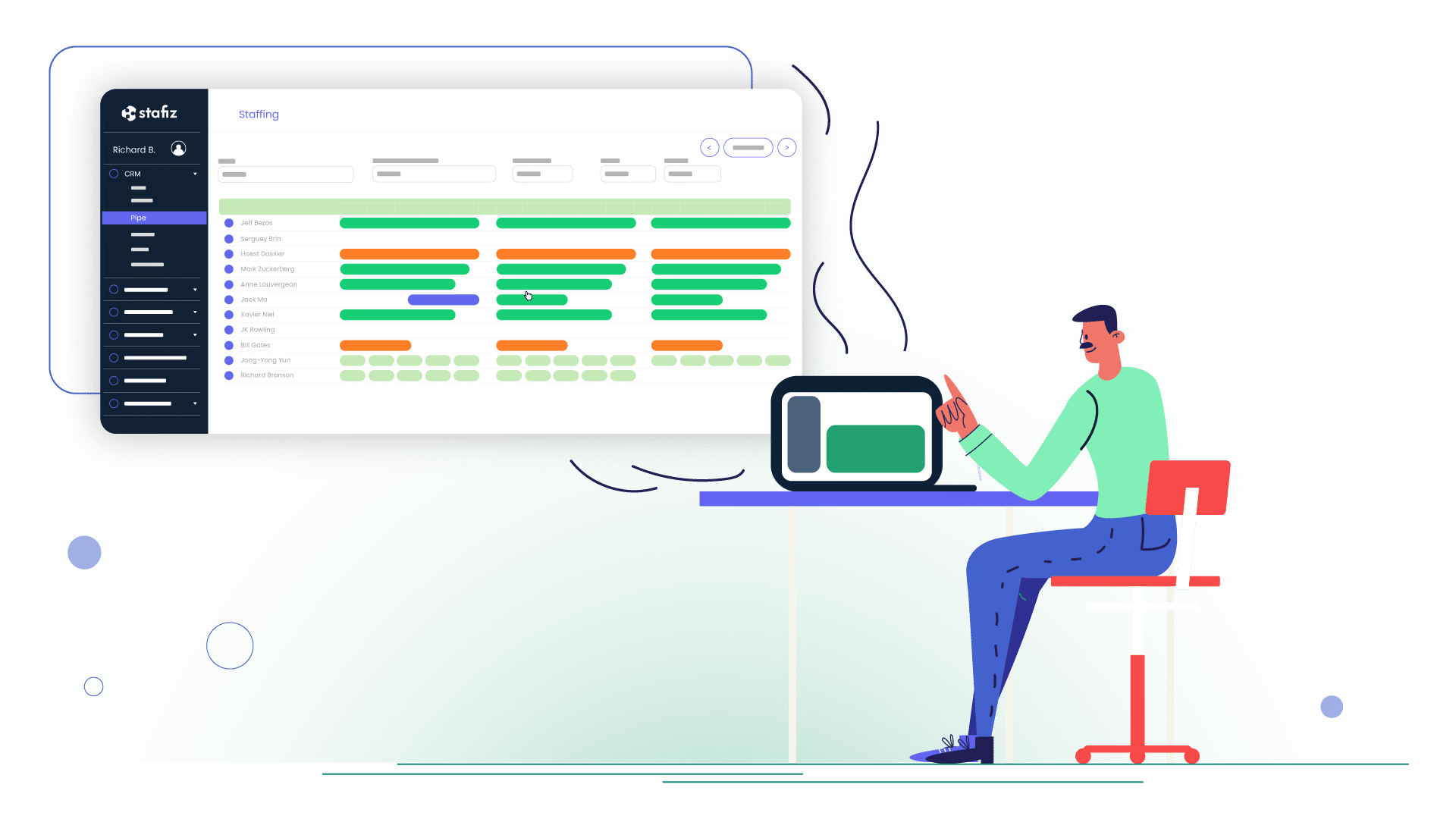The staff activity rate : a key indicator for consulting companies

Why calculate it? How to calculate it?
The 10 most important principles!
Definition of the staff activity rate
The staff activity rate or Excluded Leave Activity Rate is a human resources management indicator which measures the activity rate spent on billable activities on the basis of total availability (excluding periods of holidays, leave, sick leave, etc.).
The staff activity rate is generally expressed as a percentage and is calculated by dividing the number of hours worked on billable activities by the number of theoretical hours available after deducting leave hours.
It is used by companies, particularly consulting firms and IT Services , to assess the performance and profitability of employees or teams. It is used to make human resources management decisions.
The terms resource planning rate and utilization rate are often used synonymously with the staff activity rate.
Why take the hours spent on billable activities as the basis, rather than the entire activity?
This approach to the staff activity rate, which measures billable activity, is particularly important in IT Services , consulting companies or agencies. These companies pay the salaries of their employees each month, which represent fixed costs. For the activity to be profitable, it is necessary that each employee spends the appointment.
It is therefore a major standard indicator for all companies that sell consultants or projects to customers: consulting firms, IT Services, agencies, design offices, architectural firms, accounting firms, etc.
What is the formula for calculating the staff activity rate?
![]()
What is the difference between the staff activity rate and total working hours ?
Unlike the staff activity rate, the total working house leaves and holidays into account. The total working hours is the Leave-Included Activity Rate.
The formula for calculating TACI is as follows:
![]()
Although TACI can vary greatly from one month to the next due to vacations, it provides a closer reading of invoicing. For companies working on a time-and-materials basis, it can be interesting to monitor this indicator to better understand the results in terms of sales for a given project.
This indicator is, however, less used in practice than that of the staff activity rate.
What are the advantages and limitations of the staff activity rate as a performance indicator?
The staff activity rate as a performance indicator has several advantages:
- The staff activity rate measures the activity of an employee taking into account periods not worked. This provides more reliability on actual activity and serves as a better indicator for comparing results. Whereas an indicator which, for example, only looks at the number of days produced during a period will penalize the employee who took leave during the period in question.
- The staff activity rate makes it possible to identify employees who are overloaded and those who are underloaded. Both overload and underload penalize productivity. Overload can lead to a decline in the quality of work and employee dissatisfaction. Underload can lead to a drop in the profitability of the activity and employee dissatisfaction
- The staff activity rate makes it possible to measure performance over time, since each period is comparable
However, the staff activity rate as a performance indicator also has the following limitations:
- Without the help of a tool that calculates the staff activity rate automatically, it is not always possible to differentiate between the types of activities that generate turnover or not. For example, employees can spend time explaining or training other employees or can be active in commercial actions. We must be able to measure the time spent on this type of activity which nevertheless serves the company but which must not penalize the staff activity rate. Only a time and work management tool resource planning adapted will allow these calculations to be made automatically.
- The staff activity rate does not measure the quality of work or the contribution of employees to achieving the company's objectives. Performance must be analyzed with other indicators that complement the staff activity rate.
- In the context of a project sold at a fixed price regardless of the work carried out, the staff activity rate lacks relevance. If an unproductive employee spends 100% of their time on the billable project, they will have a high the staff activity rate, even though project performance may fall behind. This is a situation that the staff activity rate is not able to read.
- The staff activity rate can push employees to work harder to achieve objectives, even though they are overloaded and putting their health or well-being at risk.
- Certain external events, over which employees have no control, may disrupt the staff activity rate result. These external factors are not necessarily taken into account to readjust the results and penalize the reading of employee performance.
What are the standard staff activity rate in consulting?
The standard staff activity rate vary greatly depending on the industry and the profession carried out. It is therefore relevant to calculate the staff activity rate for each employee, but also to be able to consolidate them by type of profile or by type of activity.
The staff activity rate of a full-time consultant for one year with a client will thus be much higher than that of a manager responsible for several projects. The latter will spend time managing teams, perhaps selling other projects to the client. Its the staff activity rate objective must therefore be lower so as not to penalize it.
On average, successful consulting companies have the staff activity rates of around 70 to 75%. However, this figure varies, and the most junior profiles display the staff activity rates close to 75% to 85% while the most senior profiles are around 60 to 65%.
How should we interpret the staff activity rate results?
The staff activity rate results must be read from different angles:
- In comparison to the staff activity rate objective.To set a course, it is important to define an annual or monthly the staff activity rate objective when the business cycle impacts this indicator significantly. It is necessary to control the deviation of the actual the staff activity rate from the objective
- By comparing the staff activity rate of one group of people versus another group. It is interesting to go further in the analysis of the staff activity rate by grouping the staff activity rate by type of profile, or by type of team. This makes it possible to benchmark the performance of a group and set objectives at the level of a team manager.


- By checking the forecast the staff activity rateto know the gap to reach to achieve the objective. When monitoring allows it, the staff activity rate is not just an indicator looked at in the past. It also allows you to take the temperature of the forecast load in the coming months.
What factors can affect the staff activity rate?
There are many reasons why the staff activity rate is not on target. For example :
- Processes that lack efficiency: if the employee wastes time on non-productive subjects, such as administration, reporting of their work or travel as part of a project, their production will be affected and their staff activity rate will be lower than expected.
- If the workforce is underloaded, production will also be below the total theoretical capacity available. And TACE is unlikely to meet targets.
- If employees mismanage their time and spend too much time on non-billable tasks, the staff activity rate will be impacted
How can the staff activity rate be improved and what strategies can be put in place to achieve this?
Improving the staff activity rate requires above all better control of the management process of resource planning (or capacity planning). The more precise the visibility into the forecast load, the more managers will have the ability to optimize production and improve the staff activity rate.
Possible strategies to improve the staff activity rate include:
- Equip yourself with resource planning tools such as Stafiz to manage load forecasting, reduce inter-contracts and gain visibility on forecast planning. It is by far this action that makes it easiest to improve a company's staff activity rate.
- Work to simplify processes for employees working on billable projects. We need to overhaul the organization to minimize the time spent on non-billable tasks, and enable staff to concentrate on billable activities.
- Better anticipation of overload and underload to guide recruitment policies. When it is possible to anticipate under- and overloading of the business, recruitment decisions can better absorb these peaks and troughs, and ensure that capacity is better adapted to demand.
- By working to systematically reduce the intercontract, it is possible to improve the staff activity rate. To do this, we need to have more visibility into the inter-contract risk and the options for relocating employees: to be alerted when an employee is about to move to inter-contract to try to place them on another billable project; know more easily the opportunities that correspond to employees on inter-contract to reposition them…
What are the tools to calculate the staff activity rate?
Management tools resource planning allow you to follow the staff activity rate in the past and gain visibility on the forecasted staff activity rate. These tools also make it possible to identify opportunities that correspond to different profiles to avoid inter-contracting. Finally, they provide the visibility necessary to adjust recruitment policies, and always optimize capacity in relation to demand.

Discover Stafiz, the complete and predictive resource planning management tool for your teams. Gain in performance while satisfying your staff thanks to optimal management.
The importance of communicating around the staff activity rate
Once the TACE calculations have been put in place, the work doesn't stop with management or controlling. TACE must become a performance indicator that is understood and followed by all employees.
This requires training to explain why and how this indicator is tracked. It's important to use a pedagogical approach to make people understand that the aim is not to "pin down" the employee, but to improve the overall performance of the business.
Monitoring must then be made available for each employee and each manager who has a staff activity rate objective. They must be able to easily read the up-to-date staff activity rate, in real time based on the activity that has been confirmed. The more reliable and transparent the calculation, the more employees will follow this indicator and contribute to its improvement.

